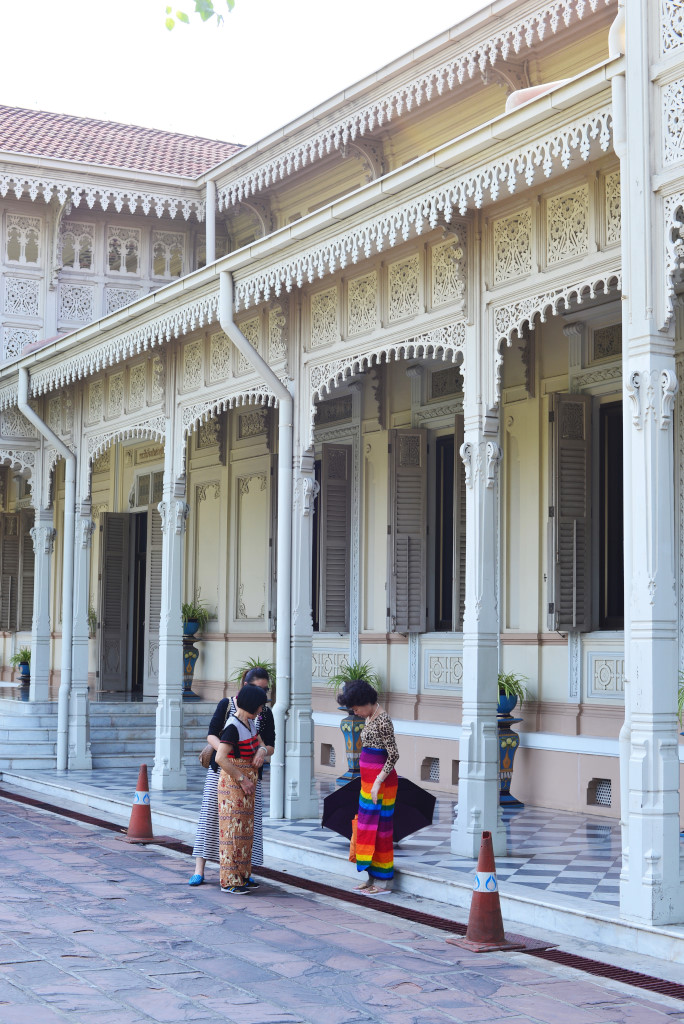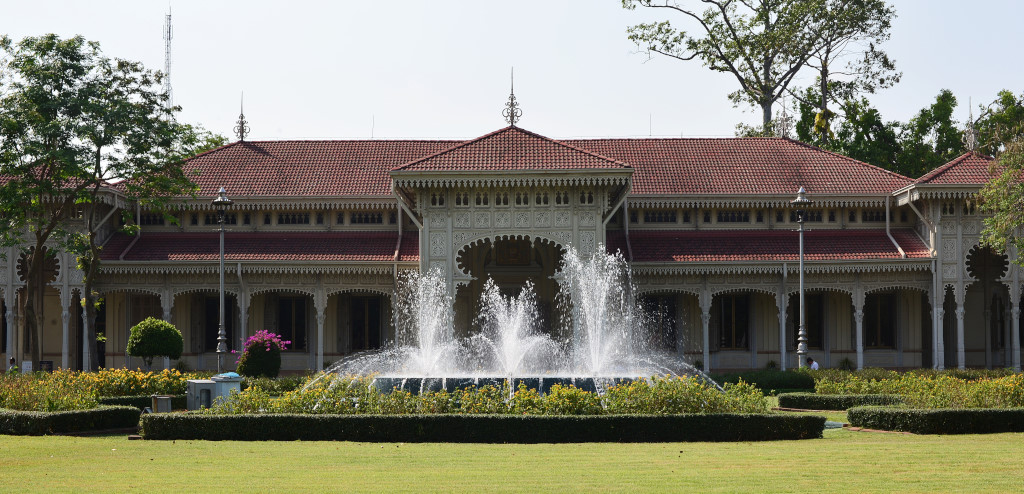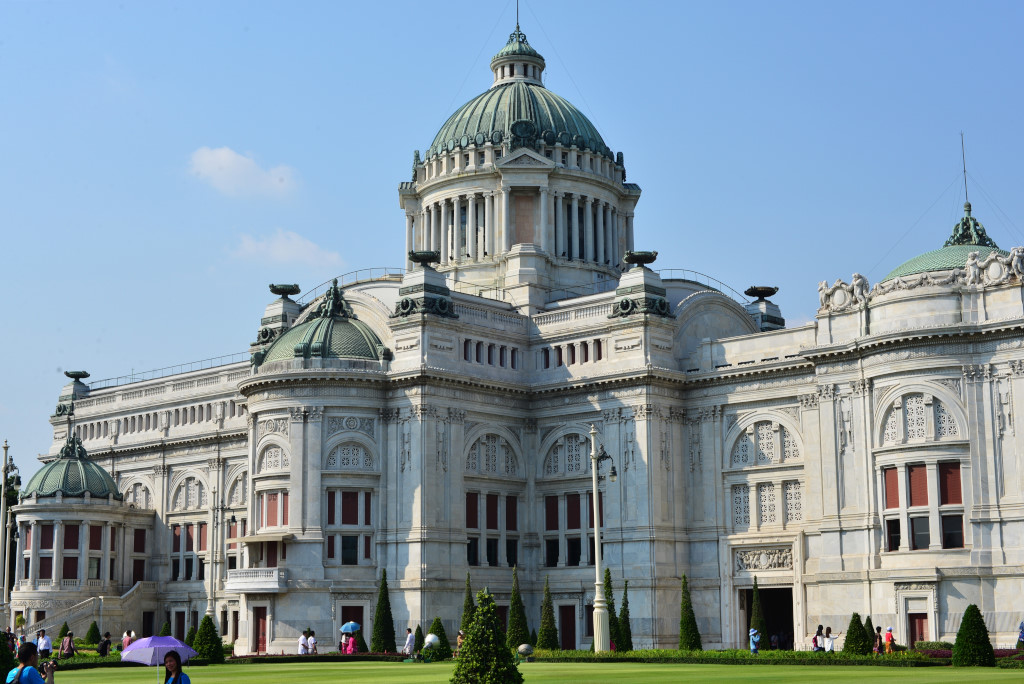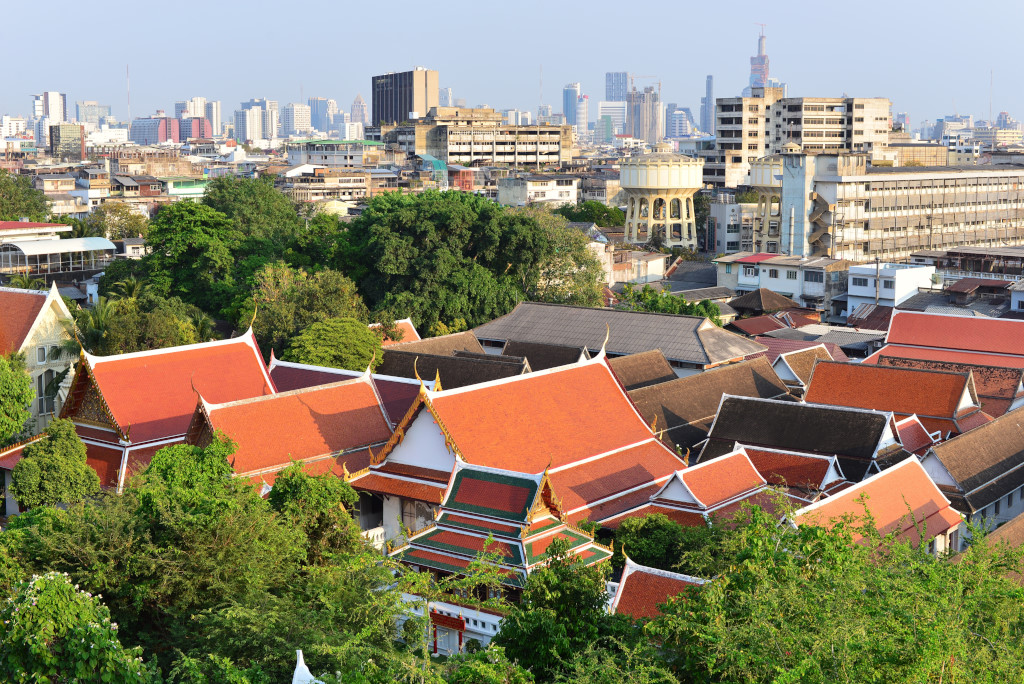March 10th, 2015
Another day of tolerating Bangkok … On one hand I feel I could just go off somewhere, hang out in some cafe or bar and wile away the day, or for that matter hang out in my hotel. And then I definitely need to catch up on my journal. On the other hand, there are still obligatory sights to see in the city that I need to check off the list, although the process feels like torture, due to the effort it takes to get anywhere, the heat, and the vast hordes of tourists that flock to the most minor site. And then the day as usual was supposed to start very early … well, I did set the alarm clock for 8:30 am and got up shortly thereafter, if that helps!

It seems the biggest motive for making an effort to see the sights in the city is the act of getting the lay of the land, so that every subsequent venture to a particular destination becomes easier. A day of small details: the small eatery near the MRT Sutthisan station is out of food, so I will probably have to eat at Victory Square, where I believe I saw small food booths lined up behind the bus station. There are almost no people on the MRT heading north, difficult as it is to believe, and in no way representative as to how the day will unfold.

The pizza slice at one of the glossy small shops at Victory Square is utterly awful – truly terrible Asian pizza. At the ground level eateries at Victory Square, a bowl of Thai soup is 25 baht and filling, unlike the equivalents that run for much more closer to the city and in formal restaurants.

The heat is really growing to unbearable limits. I have barely been on the road today, and am already drenched – and that given that most my trip was in the heavily air-conditioned metro! I just can’t get over how slowly the Thai walk, especially in these very crowded urban environments where it is difficult to navigate around people. Then again, the Thai probably are equipped with a far more pragmatic approach to traversing their city in this heat then a naive misguided farang such as myself …

I am dreading arriving at the Dusit Palace Gardens again, expecting something else to go wrong, and in a sense, it does. The palace gardens are still open to the public, although the uniformed attendant at the ticket counter tells me the entire place will close in precisely one hour. And I definitely need to cover my knees prior to entering the royal palace; I can buy a sarong next door for 100 baht, although it will just be one more thing to lug around, and I am not sure how much I can see in the time allotted.

She is entirely unamused when I try questioning the requirements for entering the teak palace. I am also not keen on leaving my bag with the $2,000 camera in their storage locker, although in theory it should be extremely safe here.

Army and police are ubiquitous, ostensibly to keep the royal property secure, although the minor interactions with this largely heavily armed male contingent don’t make the visit any more pleasant. Given that most of the attractions on the grounds are free and it is late, perhaps I could just walk around and come back tomorrow to just see the palace itself.

The mob of Chinese that I tagged behind to reach the cashier are just a taste of what is to come. Proceeding towards the throne hall and south towards the memorial palace, the crowds of package tourists grow to an overwhelming crescendo.
Group upon group of Chinese tourists clomp by, the numbers growing to the point of being utterly surreal. The palace may be interesting, and looks architecturally compelling, with intricately carved wooden siding and arched porticos fronting the expansive abode, but the rest of the buildings on the site are largely just a mediocre fantasy of European regal sensibilities.

Making matters worse, our movements along the paths are maintained under strict control by the humourless military, visibly displeased at the suggestion that I would want to take a photo of the back of one building – even though it is OK to take photos of the front. And they are all carrying big guns.

South of the complex, the area the tour buses are parked becomes visible, one group of Chinese following another erupting through the gates. Even if I wanted to approach any of the buildings around me, the crowds have swollen at the entrance to the point that movement has come to a standstill. While in theory I would want to laud the visitors for their interest in the local cultural attractions, I just want to leave, and never come back.

While the major tourist attractions of Bangkok are overwhelmed with tourists, the Dusit Palace complex must be one of the absolute nadirs. A product of its incredible marketing prowess, the experience of visiting major attractions in Thailand is now consistently stressful due to the excess numbers of peoples visiting – and it’s not as if the attractions are that memorable.

I would also be very careful anywhere close to the royal properties, given the numbers of heavily-armed soldiers spread through the bases in Dusit, waiting to enforce royal purview. Some of the kings in the country’s history stand out for their major achievements – but does that reputation necessarily extend to contemporary monarchs? To what extent are they treading water and living off the largesse that earlier rules created for them?

The very fact that they cannot in any way be questioned puts this country at the nadir of democratic systems in Southeast Asia, a region hardly known for its liberal governments, despite the apparent degree of wealth and development Thailand has. I think of Malaysia, where the king of the country is an elected sultan, and has only token power – and is sincerely loved by his people, not because demonstrating any other affection will land people in jail.

My escape route involves heading south along Thanon Ratchadamnoen, the wide, tree-lined boulevard that would be alluring in this overcrowded city if it weren’t for the fact that block upon block to the south takes me past expansive military encampments.

Along the canal that separates Thanon Luk Luang and Thanon Krung Kasem, a strange cross between country fair and Thai rice promotion is arrayed, ‘Thai Rice and Thainess’ emblazoned in Roman script on banners overhead, and indeed, most of the booths display all manners of rice to the virtually nonexistent visiting public, some stands manned by military personnel. But the fact that there are so few visitors makes it automatically compelling!

Rice is presented in bulk containers as well as sealed packages, labeling almost exclusively in Thai, hence I can only surmise the types of rice from the variety of colours, including white jasmine, red, brown, and black. It would seem that each table could represent individual farmers, communities or cooperatives, although I am not really motivated to find out, more interested in some of the ready-to-eat foodstuffs for sale. Since this is in no way geared to a tourist audience, the prices and portions are somewhat different than those found on the street closer to the centre.

One portion of acceptable red bean (or is it red rice?) ice cream is supplemented by a second and far better serving of coconut ice cream, then a large-sized cup of lime juice in ice sweetened with fresh honey. These treats are actually quite amazing! I really feel I am being spoiled, and despite the strange, patriarchal state feeling of the fair. It is also nice to be walking among real, everyday Thai people with no tourists in sight – and that including the military personnel.

On towards Thanon Nakon Sawan, the traffic heavy, the two-tone pastel buildings lining the road appealing, and virtually all of the storefronts shuttered, a few quirky small establishments still open, such as what appears to be a photo studio owned by a wizened old couple whose walls are covered with generations of portraits of Thai kings and related memorabilia.
At times it is difficult to establish the nature of a business due to the extent which whimsical embellishments bleed into the apparent business’s presentation, a charming Thai predilection.

The goal of my walk is the Golden Mount, a temple originating from the Ayutthaya period, notable for the small stupa that built on top of an artificial hill. At that time Bangkok was nothing more than a village, a far cry from the vast, faceless metropolis it is nowadays.
The hill was originally the beginnings of a gigantic pagoda built in the 18the century that eventually collapsed, and after being abandoned for some time, was used as a base for the small stupa at the peak.
The visit to Wat Saket is quite pleasurable if anything because there are only small numbers of independent travelers visiting, an incredible relief from the zoo at the Dusit Palace Gardens.

Inside the grounds of the Golden Mount, the painted stone staircase climbs through the dense green foliage into a different world, up to a platform with a row of heavy bronze bells and a large gong, then further up towards the peak, the vistas of the city opening up around me as the final climb broaches the unassuming terrace centred on the stupa itself.

The city’s relentless concrete is interrupted to some degree with the terracotta gabling and golden bargeboards of the surrounding temple buildings as well as those further in the distance, grids of shop houses interrupting the dull uniformity of this overgrown concrete-infested sprawl.

As with many of the temples in the central Bangkok area, the hand of royal patronage is apparent in terms of the opulence of the buildings of worship as well as the monastic residences. A group of decorous orange-clad monks files out of one of the ground-level temples as dusk approaches, the burning disk of the sun receding behind the temple mount.

The adjacent streets around the temple are traditional two-storied shop houses, large shuttered windows set into the stone buildings, mostly given over to workshops and industrial component dealers, each street reflecting its respective specializations.

I had wanted to see some of the architecturally historic areas of this part of the inner city, but can’t seem to place the areas now that I had seen several months ago. Wandering past the bulging automotive and industrial workshops along Thanon Wara Chak and then Thanon Luang, I arrive deeper into the guts of the city, then head north through the territories deep in the centre of the city that no farang ever bothers coming near – and as far removed from rapid transit as it gets.

At Thanon Lan Luang, I wave off the tuktuk drivers as I trudge through one set of market stalls being taken down for the day, only to re-enter the fray of the night market being set up on Thanon Krung Kasem, on the long journey back to Hua Lamphong station, the calluses on my poor feet crying out for succor.

But I soldier on, enjoying dinner in the darkness at the traffic circle joining Thanon Maitrichit and Thanon Mittraphan, the bleakness around me enhanced by the solitary prostitutes cruising for business, a glint of desperation in their eyes as I eat the river fish steamed in lime leaf with a vaguely rank tamarind dressing. The fringes of Chinatown leading toward the train station are as atmospheric and surreal as always, a perfect venue for a latter-day Roman Polanski film.

The metro is almost empty at Hua Lamphong, but that is about to change, within short order the train absolutely packed, almost exclusively young people, 2/3 of which are female. I have to hand it to the Thai for being so polite in dealing with such challenging circumstances … although virtually everyone is glued to their cell phone display, oblivious of the world around them.
And after another long haul of a day, am I ever glad to be able to walk into my comfortable air-conditioned hotel room!


